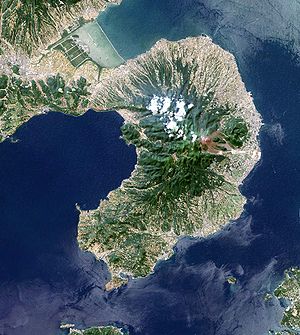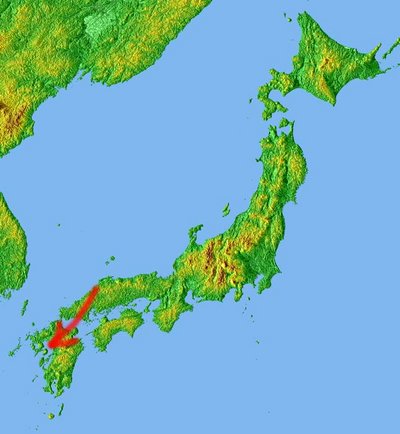
Shimabara Peninsula
Encyclopedia

Nagasaki Prefecture
is a prefecture of Japan located on the island of Kyūshū. The capital is the city of Nagasaki.- History :Nagasaki Prefecture was created by merging of the western half of the former province of Hizen with the island provinces of Tsushima and Iki...
, Kyūshū
Kyushu
is the third largest island of Japan and most southwesterly of its four main islands. Its alternate ancient names include , , and . The historical regional name is referred to Kyushu and its surrounding islands....
, Japan
Japan
Japan is an island nation in East Asia. Located in the Pacific Ocean, it lies to the east of the Sea of Japan, China, North Korea, South Korea and Russia, stretching from the Sea of Okhotsk in the north to the East China Sea and Taiwan in the south...
. On its north-eastern tip stands Shimabara City
Shimabara, Nagasaki
is a city located on the north-eastern tip of the Shimabara Peninsula, facing Ariake Bay in the east and Mount Unzen in the west, in Nagasaki Prefecture, Kyūshū, Japan.-History:...
. It was also the site of the Shimabara Rebellion
Shimabara Rebellion
The was an uprising largely involving Japanese peasants, most of them Catholic Christians, in 1637–1638 during the Edo period.It was one of only a handful of instances of serious unrest during the relatively peaceful period of the Tokugawa shogunate's rule...
, a 1637-1638 peasant revolt led by Christians. This further reinforced distrust of Christians and foreigners by Shogun Iemitsu and contributed to the 1639 decision to isolate Japan from the outside world. From then on the Dutch and the Chinese were the only ones permitted to enter Japan through Nagasaki in a very limited fashion until Japan was reopened again (Hane, Modern Japan: A Historical Survey, p. 24).


